International Undergraduate Program Strategic Management Report: Zara
VerifiedAdded on 2021/06/07
|64
|16204
|1069
Report
AI Summary
This comprehensive strategic management report analyzes Zara, a leading fashion retailer. It begins with a company background, vision, and mission statement analysis, followed by an external assessment using Porter's Five Forces and an EFE matrix. The internal assessment examines resource-based view, IFE matrix, and financial analysis. The report then delves into Zara's strategies, including Porter's generic strategies, and strategy analysis using SWOT, SPACE, BCG, IE, Grand Strategy, and QSPM matrices. Further sections cover implementing strategies across marketing, finance, R&D, and MIS, followed by strategy evaluation using the Balanced Scorecard and a discussion of globalization culture. The report concludes with Zara's competitive advantages, vision, mission, and strategic recommendations. The report is a detailed analysis of Zara's business model and strategic approach to the fashion industry.
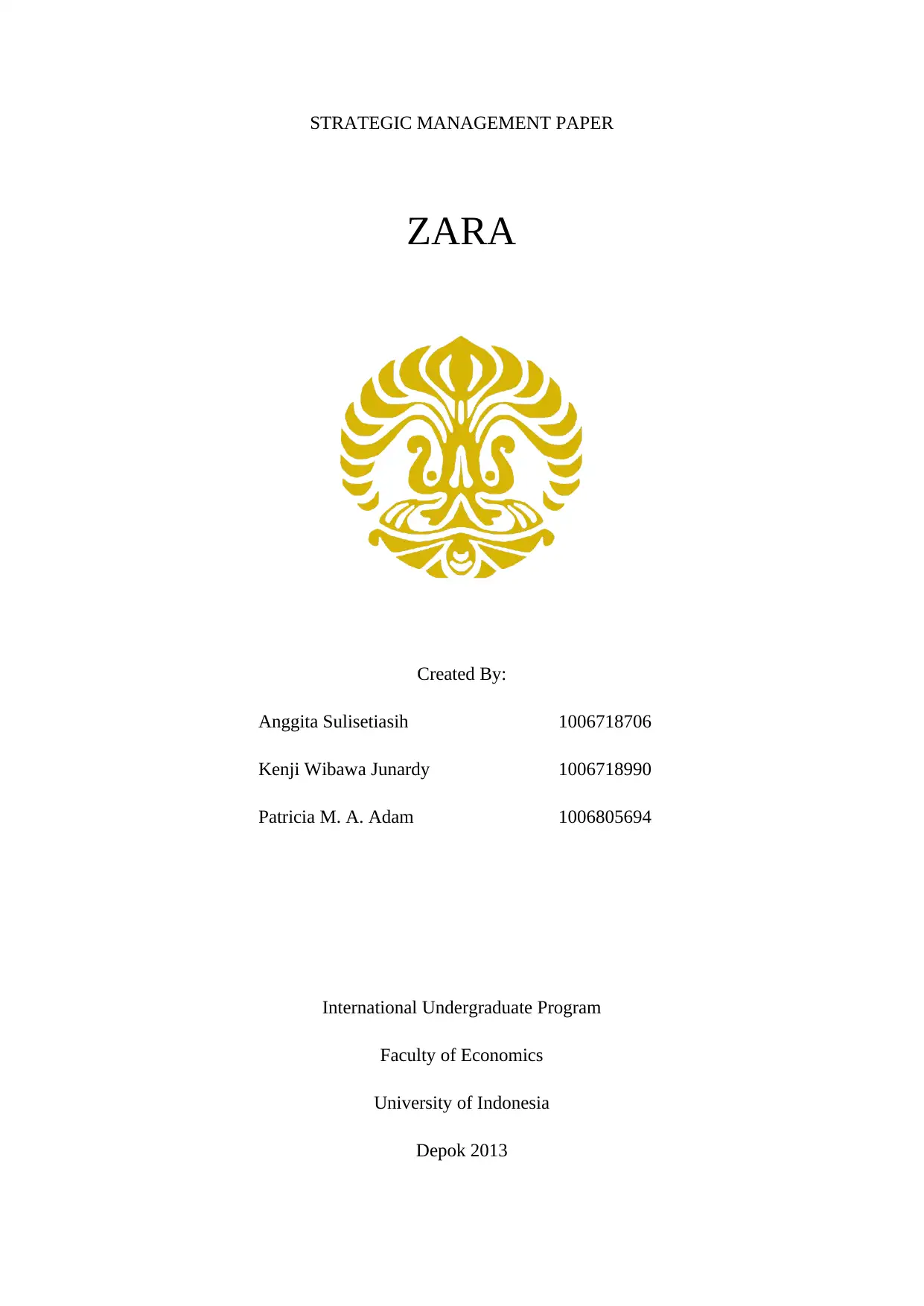
STRATEGIC MANAGEMENT PAPER
ZARA
Created By:
Anggita Sulisetiasih 1006718706
Kenji Wibawa Junardy 1006718990
Patricia M. A. Adam 1006805694
International Undergraduate Program
Faculty of Economics
University of Indonesia
Depok 2013
ZARA
Created By:
Anggita Sulisetiasih 1006718706
Kenji Wibawa Junardy 1006718990
Patricia M. A. Adam 1006805694
International Undergraduate Program
Faculty of Economics
University of Indonesia
Depok 2013
Paraphrase This Document
Need a fresh take? Get an instant paraphrase of this document with our AI Paraphraser
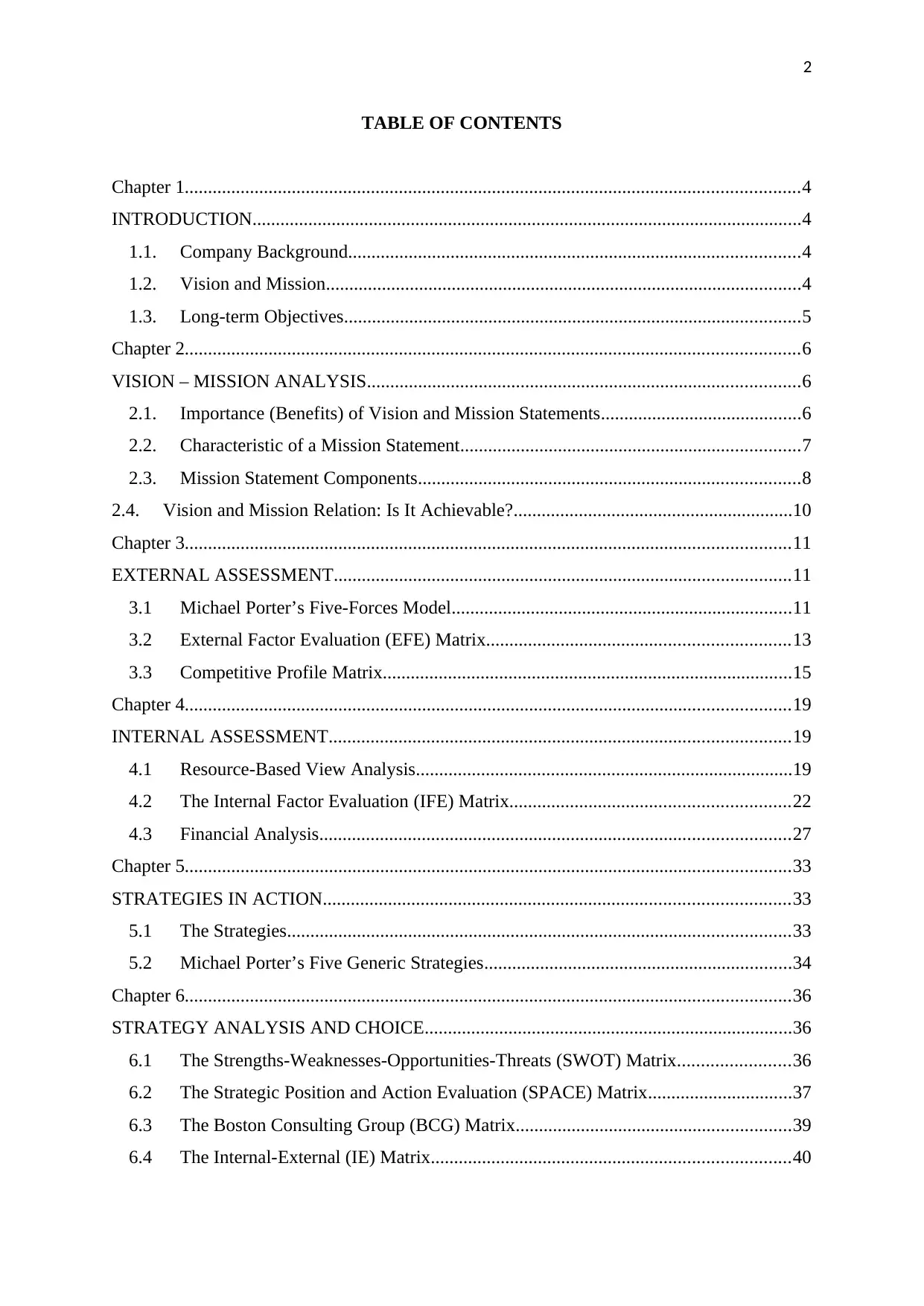
2
TABLE OF CONTENTS
Chapter 1....................................................................................................................................4
INTRODUCTION......................................................................................................................4
1.1. Company Background.................................................................................................4
1.2. Vision and Mission......................................................................................................4
1.3. Long-term Objectives..................................................................................................5
Chapter 2....................................................................................................................................6
VISION – MISSION ANALYSIS.............................................................................................6
2.1. Importance (Benefits) of Vision and Mission Statements...........................................6
2.2. Characteristic of a Mission Statement.........................................................................7
2.3. Mission Statement Components..................................................................................8
2.4. Vision and Mission Relation: Is It Achievable?............................................................10
Chapter 3..................................................................................................................................11
EXTERNAL ASSESSMENT..................................................................................................11
3.1 Michael Porter’s Five-Forces Model.........................................................................11
3.2 External Factor Evaluation (EFE) Matrix.................................................................13
3.3 Competitive Profile Matrix........................................................................................15
Chapter 4..................................................................................................................................19
INTERNAL ASSESSMENT...................................................................................................19
4.1 Resource-Based View Analysis.................................................................................19
4.2 The Internal Factor Evaluation (IFE) Matrix............................................................22
4.3 Financial Analysis.....................................................................................................27
Chapter 5..................................................................................................................................33
STRATEGIES IN ACTION....................................................................................................33
5.1 The Strategies............................................................................................................33
5.2 Michael Porter’s Five Generic Strategies..................................................................34
Chapter 6..................................................................................................................................36
STRATEGY ANALYSIS AND CHOICE...............................................................................36
6.1 The Strengths-Weaknesses-Opportunities-Threats (SWOT) Matrix........................36
6.2 The Strategic Position and Action Evaluation (SPACE) Matrix...............................37
6.3 The Boston Consulting Group (BCG) Matrix...........................................................39
6.4 The Internal-External (IE) Matrix.............................................................................40
TABLE OF CONTENTS
Chapter 1....................................................................................................................................4
INTRODUCTION......................................................................................................................4
1.1. Company Background.................................................................................................4
1.2. Vision and Mission......................................................................................................4
1.3. Long-term Objectives..................................................................................................5
Chapter 2....................................................................................................................................6
VISION – MISSION ANALYSIS.............................................................................................6
2.1. Importance (Benefits) of Vision and Mission Statements...........................................6
2.2. Characteristic of a Mission Statement.........................................................................7
2.3. Mission Statement Components..................................................................................8
2.4. Vision and Mission Relation: Is It Achievable?............................................................10
Chapter 3..................................................................................................................................11
EXTERNAL ASSESSMENT..................................................................................................11
3.1 Michael Porter’s Five-Forces Model.........................................................................11
3.2 External Factor Evaluation (EFE) Matrix.................................................................13
3.3 Competitive Profile Matrix........................................................................................15
Chapter 4..................................................................................................................................19
INTERNAL ASSESSMENT...................................................................................................19
4.1 Resource-Based View Analysis.................................................................................19
4.2 The Internal Factor Evaluation (IFE) Matrix............................................................22
4.3 Financial Analysis.....................................................................................................27
Chapter 5..................................................................................................................................33
STRATEGIES IN ACTION....................................................................................................33
5.1 The Strategies............................................................................................................33
5.2 Michael Porter’s Five Generic Strategies..................................................................34
Chapter 6..................................................................................................................................36
STRATEGY ANALYSIS AND CHOICE...............................................................................36
6.1 The Strengths-Weaknesses-Opportunities-Threats (SWOT) Matrix........................36
6.2 The Strategic Position and Action Evaluation (SPACE) Matrix...............................37
6.3 The Boston Consulting Group (BCG) Matrix...........................................................39
6.4 The Internal-External (IE) Matrix.............................................................................40
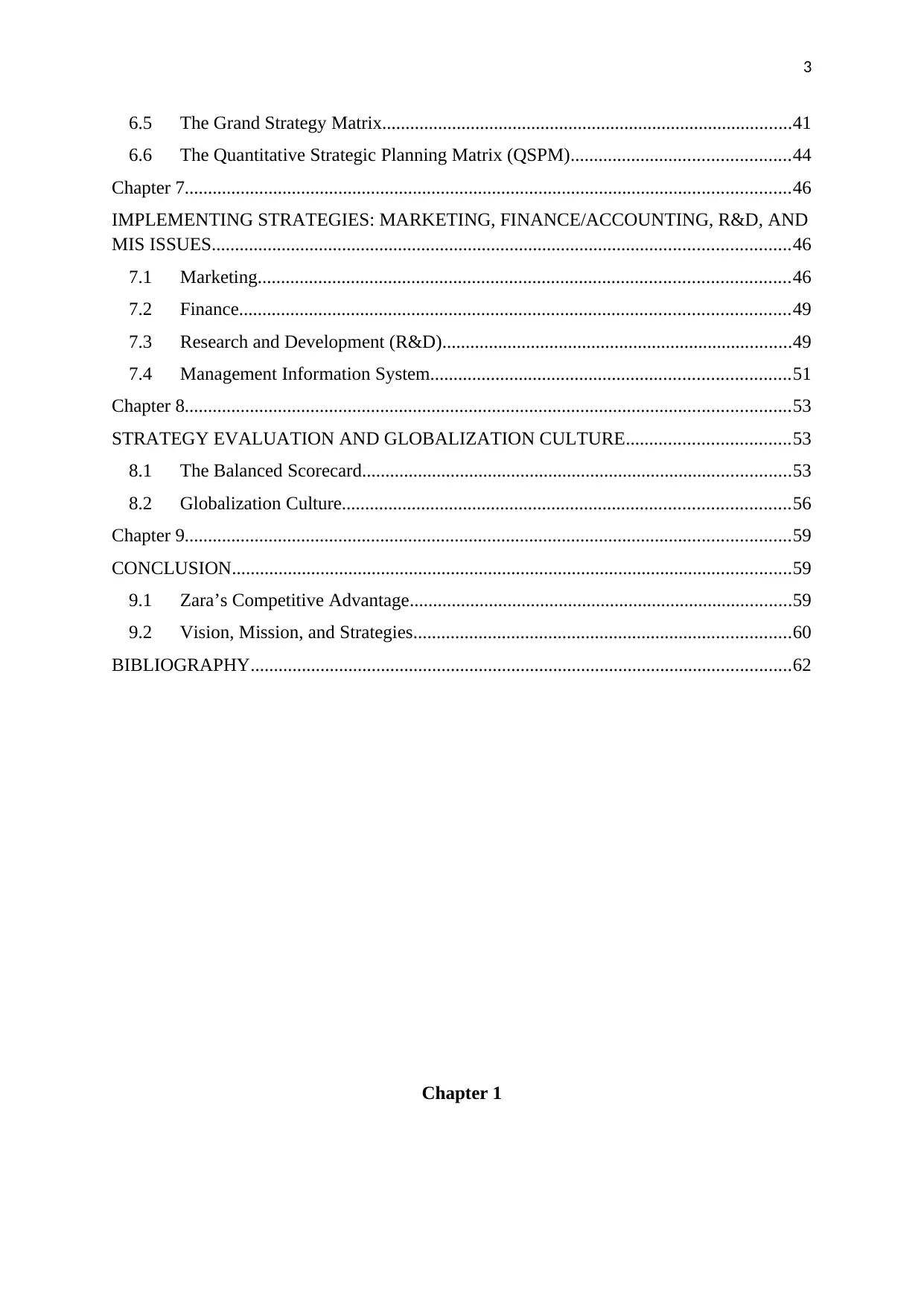
3
6.5 The Grand Strategy Matrix........................................................................................41
6.6 The Quantitative Strategic Planning Matrix (QSPM)...............................................44
Chapter 7..................................................................................................................................46
IMPLEMENTING STRATEGIES: MARKETING, FINANCE/ACCOUNTING, R&D, AND
MIS ISSUES............................................................................................................................46
7.1 Marketing..................................................................................................................46
7.2 Finance......................................................................................................................49
7.3 Research and Development (R&D)...........................................................................49
7.4 Management Information System.............................................................................51
Chapter 8..................................................................................................................................53
STRATEGY EVALUATION AND GLOBALIZATION CULTURE...................................53
8.1 The Balanced Scorecard............................................................................................53
8.2 Globalization Culture................................................................................................56
Chapter 9..................................................................................................................................59
CONCLUSION........................................................................................................................59
9.1 Zara’s Competitive Advantage..................................................................................59
9.2 Vision, Mission, and Strategies.................................................................................60
BIBLIOGRAPHY....................................................................................................................62
Chapter 1
6.5 The Grand Strategy Matrix........................................................................................41
6.6 The Quantitative Strategic Planning Matrix (QSPM)...............................................44
Chapter 7..................................................................................................................................46
IMPLEMENTING STRATEGIES: MARKETING, FINANCE/ACCOUNTING, R&D, AND
MIS ISSUES............................................................................................................................46
7.1 Marketing..................................................................................................................46
7.2 Finance......................................................................................................................49
7.3 Research and Development (R&D)...........................................................................49
7.4 Management Information System.............................................................................51
Chapter 8..................................................................................................................................53
STRATEGY EVALUATION AND GLOBALIZATION CULTURE...................................53
8.1 The Balanced Scorecard............................................................................................53
8.2 Globalization Culture................................................................................................56
Chapter 9..................................................................................................................................59
CONCLUSION........................................................................................................................59
9.1 Zara’s Competitive Advantage..................................................................................59
9.2 Vision, Mission, and Strategies.................................................................................60
BIBLIOGRAPHY....................................................................................................................62
Chapter 1
⊘ This is a preview!⊘
Do you want full access?
Subscribe today to unlock all pages.

Trusted by 1+ million students worldwide
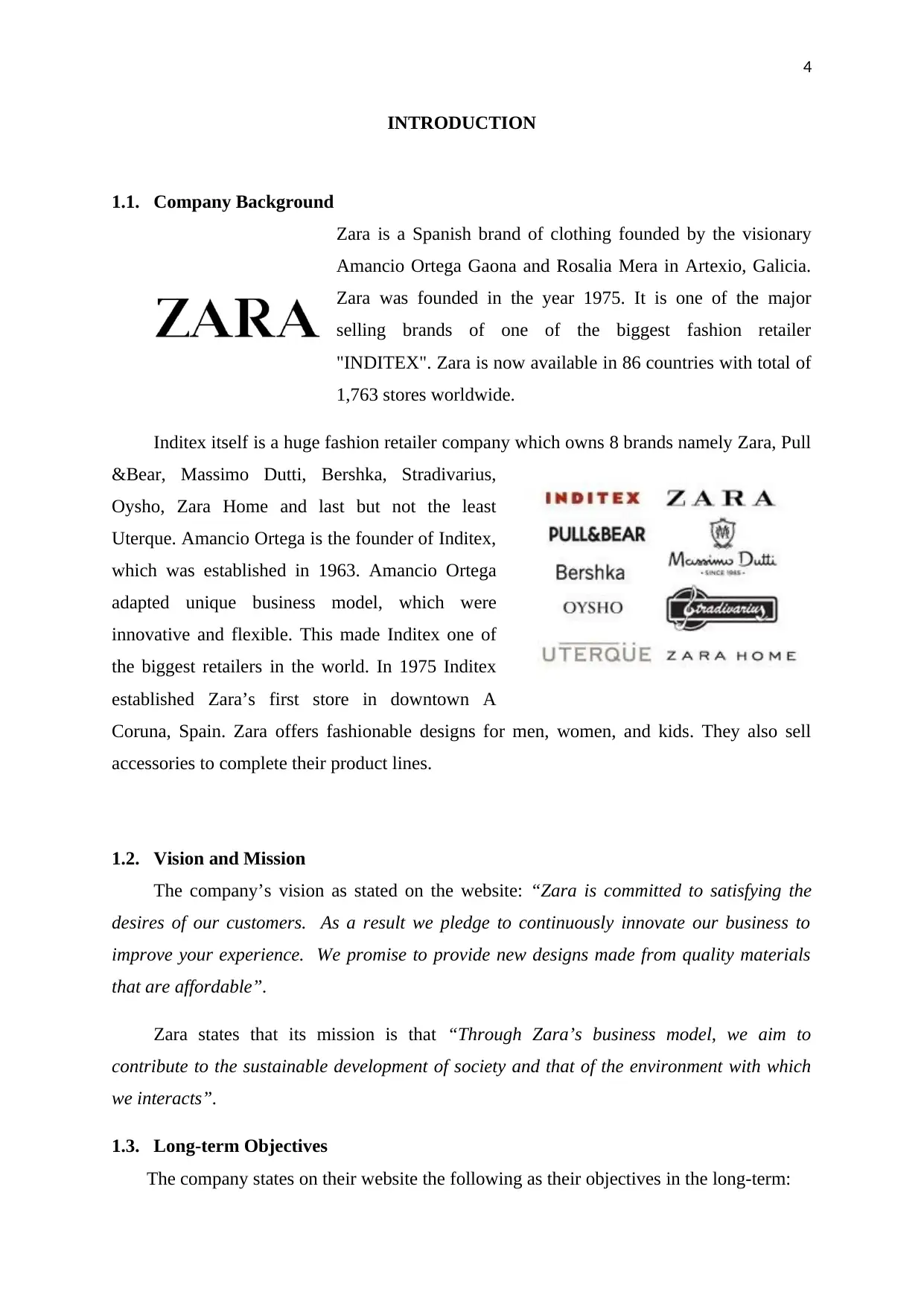
4
INTRODUCTION
1.1. Company Background
Zara is a Spanish brand of clothing founded by the visionary
Amancio Ortega Gaona and Rosalia Mera in Artexio, Galicia.
Zara was founded in the year 1975. It is one of the major
selling brands of one of the biggest fashion retailer
"INDITEX". Zara is now available in 86 countries with total of
1,763 stores worldwide.
Inditex itself is a huge fashion retailer company which owns 8 brands namely Zara, Pull
&Bear, Massimo Dutti, Bershka, Stradivarius,
Oysho, Zara Home and last but not the least
Uterque. Amancio Ortega is the founder of Inditex,
which was established in 1963. Amancio Ortega
adapted unique business model, which were
innovative and flexible. This made Inditex one of
the biggest retailers in the world. In 1975 Inditex
established Zara’s first store in downtown A
Coruna, Spain. Zara offers fashionable designs for men, women, and kids. They also sell
accessories to complete their product lines.
1.2. Vision and Mission
The company’s vision as stated on the website: “Zara is committed to satisfying the
desires of our customers. As a result we pledge to continuously innovate our business to
improve your experience. We promise to provide new designs made from quality materials
that are affordable”.
Zara states that its mission is that “Through Zara’s business model, we aim to
contribute to the sustainable development of society and that of the environment with which
we interacts”.
1.3. Long-term Objectives
The company states on their website the following as their objectives in the long-term:
INTRODUCTION
1.1. Company Background
Zara is a Spanish brand of clothing founded by the visionary
Amancio Ortega Gaona and Rosalia Mera in Artexio, Galicia.
Zara was founded in the year 1975. It is one of the major
selling brands of one of the biggest fashion retailer
"INDITEX". Zara is now available in 86 countries with total of
1,763 stores worldwide.
Inditex itself is a huge fashion retailer company which owns 8 brands namely Zara, Pull
&Bear, Massimo Dutti, Bershka, Stradivarius,
Oysho, Zara Home and last but not the least
Uterque. Amancio Ortega is the founder of Inditex,
which was established in 1963. Amancio Ortega
adapted unique business model, which were
innovative and flexible. This made Inditex one of
the biggest retailers in the world. In 1975 Inditex
established Zara’s first store in downtown A
Coruna, Spain. Zara offers fashionable designs for men, women, and kids. They also sell
accessories to complete their product lines.
1.2. Vision and Mission
The company’s vision as stated on the website: “Zara is committed to satisfying the
desires of our customers. As a result we pledge to continuously innovate our business to
improve your experience. We promise to provide new designs made from quality materials
that are affordable”.
Zara states that its mission is that “Through Zara’s business model, we aim to
contribute to the sustainable development of society and that of the environment with which
we interacts”.
1.3. Long-term Objectives
The company states on their website the following as their objectives in the long-term:
Paraphrase This Document
Need a fresh take? Get an instant paraphrase of this document with our AI Paraphraser
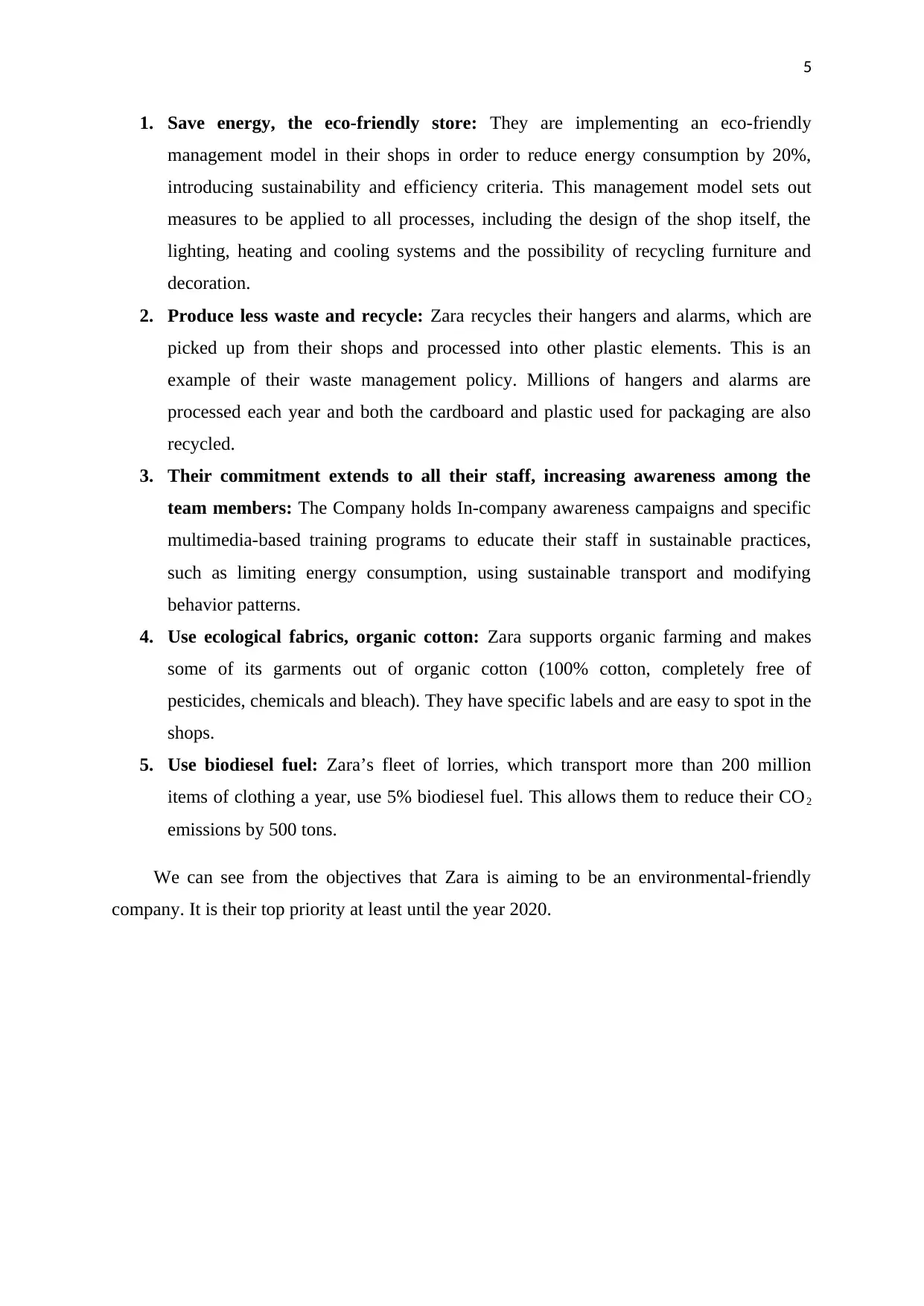
5
1. Save energy, the eco-friendly store: They are implementing an eco-friendly
management model in their shops in order to reduce energy consumption by 20%,
introducing sustainability and efficiency criteria. This management model sets out
measures to be applied to all processes, including the design of the shop itself, the
lighting, heating and cooling systems and the possibility of recycling furniture and
decoration.
2. Produce less waste and recycle: Zara recycles their hangers and alarms, which are
picked up from their shops and processed into other plastic elements. This is an
example of their waste management policy. Millions of hangers and alarms are
processed each year and both the cardboard and plastic used for packaging are also
recycled.
3. Their commitment extends to all their staff, increasing awareness among the
team members: The Company holds In-company awareness campaigns and specific
multimedia-based training programs to educate their staff in sustainable practices,
such as limiting energy consumption, using sustainable transport and modifying
behavior patterns.
4. Use ecological fabrics, organic cotton: Zara supports organic farming and makes
some of its garments out of organic cotton (100% cotton, completely free of
pesticides, chemicals and bleach). They have specific labels and are easy to spot in the
shops.
5. Use biodiesel fuel: Zara’s fleet of lorries, which transport more than 200 million
items of clothing a year, use 5% biodiesel fuel. This allows them to reduce their CO2
emissions by 500 tons.
We can see from the objectives that Zara is aiming to be an environmental-friendly
company. It is their top priority at least until the year 2020.
1. Save energy, the eco-friendly store: They are implementing an eco-friendly
management model in their shops in order to reduce energy consumption by 20%,
introducing sustainability and efficiency criteria. This management model sets out
measures to be applied to all processes, including the design of the shop itself, the
lighting, heating and cooling systems and the possibility of recycling furniture and
decoration.
2. Produce less waste and recycle: Zara recycles their hangers and alarms, which are
picked up from their shops and processed into other plastic elements. This is an
example of their waste management policy. Millions of hangers and alarms are
processed each year and both the cardboard and plastic used for packaging are also
recycled.
3. Their commitment extends to all their staff, increasing awareness among the
team members: The Company holds In-company awareness campaigns and specific
multimedia-based training programs to educate their staff in sustainable practices,
such as limiting energy consumption, using sustainable transport and modifying
behavior patterns.
4. Use ecological fabrics, organic cotton: Zara supports organic farming and makes
some of its garments out of organic cotton (100% cotton, completely free of
pesticides, chemicals and bleach). They have specific labels and are easy to spot in the
shops.
5. Use biodiesel fuel: Zara’s fleet of lorries, which transport more than 200 million
items of clothing a year, use 5% biodiesel fuel. This allows them to reduce their CO2
emissions by 500 tons.
We can see from the objectives that Zara is aiming to be an environmental-friendly
company. It is their top priority at least until the year 2020.
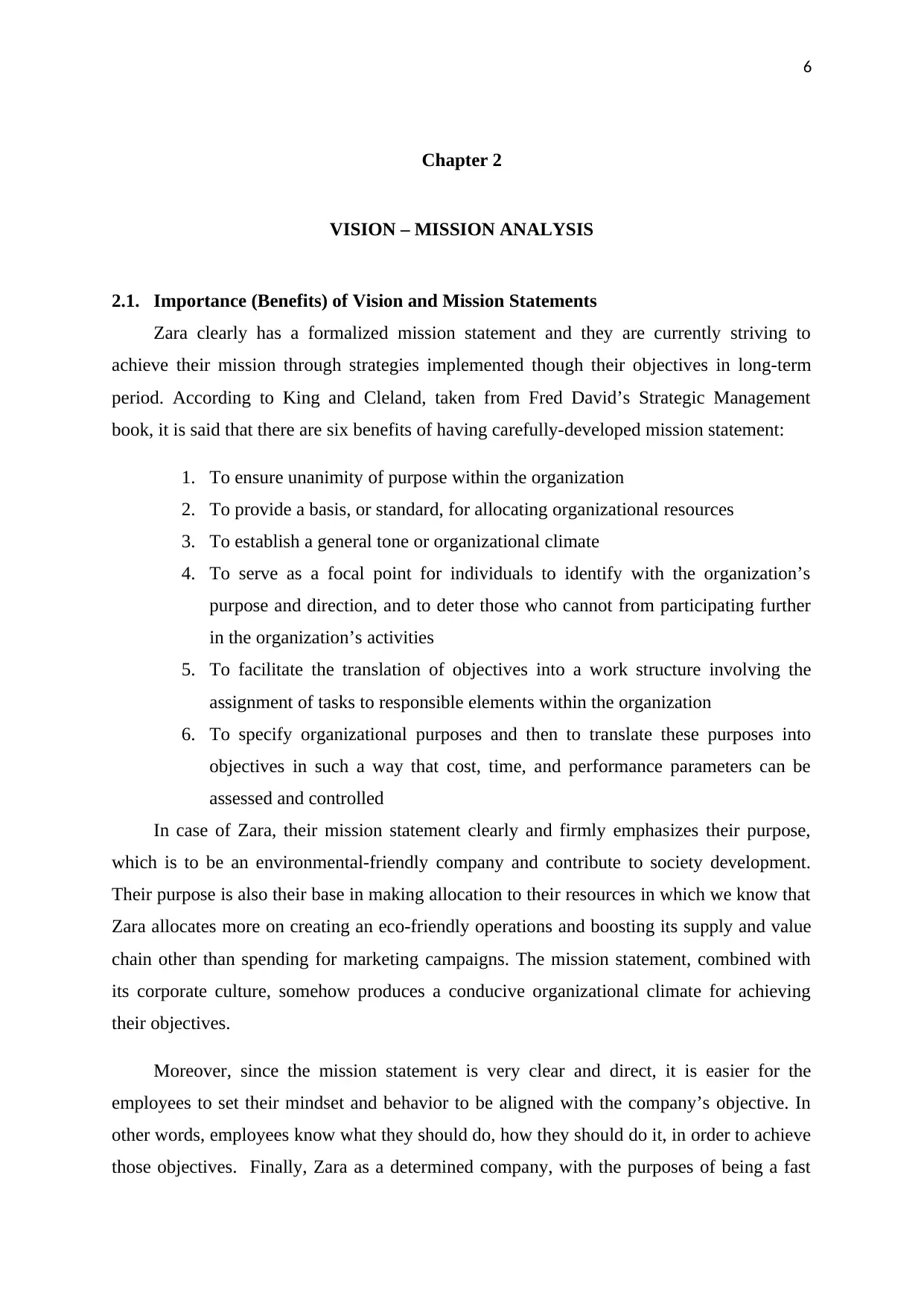
6
Chapter 2
VISION – MISSION ANALYSIS
2.1. Importance (Benefits) of Vision and Mission Statements
Zara clearly has a formalized mission statement and they are currently striving to
achieve their mission through strategies implemented though their objectives in long-term
period. According to King and Cleland, taken from Fred David’s Strategic Management
book, it is said that there are six benefits of having carefully-developed mission statement:
1. To ensure unanimity of purpose within the organization
2. To provide a basis, or standard, for allocating organizational resources
3. To establish a general tone or organizational climate
4. To serve as a focal point for individuals to identify with the organization’s
purpose and direction, and to deter those who cannot from participating further
in the organization’s activities
5. To facilitate the translation of objectives into a work structure involving the
assignment of tasks to responsible elements within the organization
6. To specify organizational purposes and then to translate these purposes into
objectives in such a way that cost, time, and performance parameters can be
assessed and controlled
In case of Zara, their mission statement clearly and firmly emphasizes their purpose,
which is to be an environmental-friendly company and contribute to society development.
Their purpose is also their base in making allocation to their resources in which we know that
Zara allocates more on creating an eco-friendly operations and boosting its supply and value
chain other than spending for marketing campaigns. The mission statement, combined with
its corporate culture, somehow produces a conducive organizational climate for achieving
their objectives.
Moreover, since the mission statement is very clear and direct, it is easier for the
employees to set their mindset and behavior to be aligned with the company’s objective. In
other words, employees know what they should do, how they should do it, in order to achieve
those objectives. Finally, Zara as a determined company, with the purposes of being a fast
Chapter 2
VISION – MISSION ANALYSIS
2.1. Importance (Benefits) of Vision and Mission Statements
Zara clearly has a formalized mission statement and they are currently striving to
achieve their mission through strategies implemented though their objectives in long-term
period. According to King and Cleland, taken from Fred David’s Strategic Management
book, it is said that there are six benefits of having carefully-developed mission statement:
1. To ensure unanimity of purpose within the organization
2. To provide a basis, or standard, for allocating organizational resources
3. To establish a general tone or organizational climate
4. To serve as a focal point for individuals to identify with the organization’s
purpose and direction, and to deter those who cannot from participating further
in the organization’s activities
5. To facilitate the translation of objectives into a work structure involving the
assignment of tasks to responsible elements within the organization
6. To specify organizational purposes and then to translate these purposes into
objectives in such a way that cost, time, and performance parameters can be
assessed and controlled
In case of Zara, their mission statement clearly and firmly emphasizes their purpose,
which is to be an environmental-friendly company and contribute to society development.
Their purpose is also their base in making allocation to their resources in which we know that
Zara allocates more on creating an eco-friendly operations and boosting its supply and value
chain other than spending for marketing campaigns. The mission statement, combined with
its corporate culture, somehow produces a conducive organizational climate for achieving
their objectives.
Moreover, since the mission statement is very clear and direct, it is easier for the
employees to set their mindset and behavior to be aligned with the company’s objective. In
other words, employees know what they should do, how they should do it, in order to achieve
those objectives. Finally, Zara as a determined company, with the purposes of being a fast
⊘ This is a preview!⊘
Do you want full access?
Subscribe today to unlock all pages.

Trusted by 1+ million students worldwide
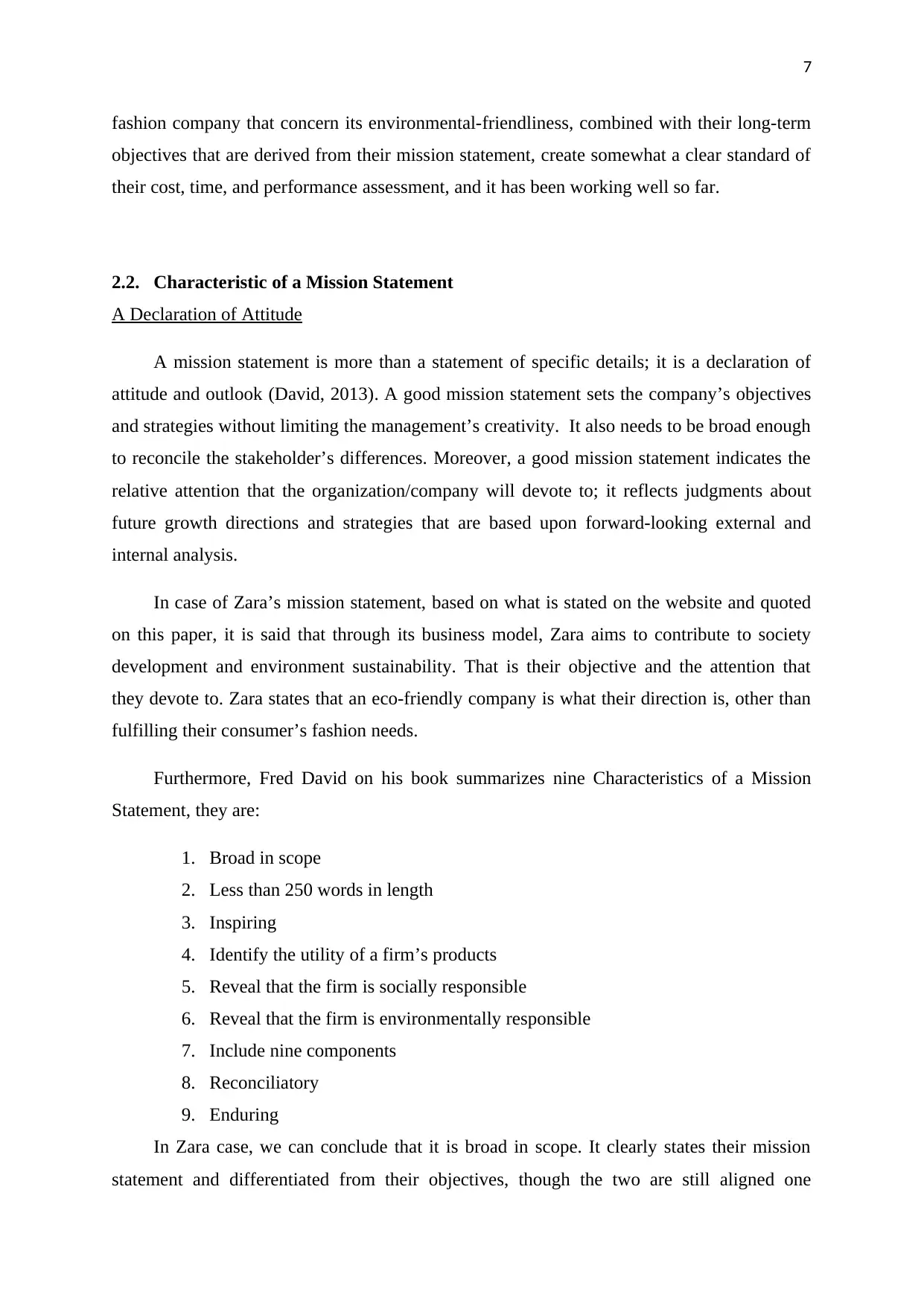
7
fashion company that concern its environmental-friendliness, combined with their long-term
objectives that are derived from their mission statement, create somewhat a clear standard of
their cost, time, and performance assessment, and it has been working well so far.
2.2. Characteristic of a Mission Statement
A Declaration of Attitude
A mission statement is more than a statement of specific details; it is a declaration of
attitude and outlook (David, 2013). A good mission statement sets the company’s objectives
and strategies without limiting the management’s creativity. It also needs to be broad enough
to reconcile the stakeholder’s differences. Moreover, a good mission statement indicates the
relative attention that the organization/company will devote to; it reflects judgments about
future growth directions and strategies that are based upon forward-looking external and
internal analysis.
In case of Zara’s mission statement, based on what is stated on the website and quoted
on this paper, it is said that through its business model, Zara aims to contribute to society
development and environment sustainability. That is their objective and the attention that
they devote to. Zara states that an eco-friendly company is what their direction is, other than
fulfilling their consumer’s fashion needs.
Furthermore, Fred David on his book summarizes nine Characteristics of a Mission
Statement, they are:
1. Broad in scope
2. Less than 250 words in length
3. Inspiring
4. Identify the utility of a firm’s products
5. Reveal that the firm is socially responsible
6. Reveal that the firm is environmentally responsible
7. Include nine components
8. Reconciliatory
9. Enduring
In Zara case, we can conclude that it is broad in scope. It clearly states their mission
statement and differentiated from their objectives, though the two are still aligned one
fashion company that concern its environmental-friendliness, combined with their long-term
objectives that are derived from their mission statement, create somewhat a clear standard of
their cost, time, and performance assessment, and it has been working well so far.
2.2. Characteristic of a Mission Statement
A Declaration of Attitude
A mission statement is more than a statement of specific details; it is a declaration of
attitude and outlook (David, 2013). A good mission statement sets the company’s objectives
and strategies without limiting the management’s creativity. It also needs to be broad enough
to reconcile the stakeholder’s differences. Moreover, a good mission statement indicates the
relative attention that the organization/company will devote to; it reflects judgments about
future growth directions and strategies that are based upon forward-looking external and
internal analysis.
In case of Zara’s mission statement, based on what is stated on the website and quoted
on this paper, it is said that through its business model, Zara aims to contribute to society
development and environment sustainability. That is their objective and the attention that
they devote to. Zara states that an eco-friendly company is what their direction is, other than
fulfilling their consumer’s fashion needs.
Furthermore, Fred David on his book summarizes nine Characteristics of a Mission
Statement, they are:
1. Broad in scope
2. Less than 250 words in length
3. Inspiring
4. Identify the utility of a firm’s products
5. Reveal that the firm is socially responsible
6. Reveal that the firm is environmentally responsible
7. Include nine components
8. Reconciliatory
9. Enduring
In Zara case, we can conclude that it is broad in scope. It clearly states their mission
statement and differentiated from their objectives, though the two are still aligned one
Paraphrase This Document
Need a fresh take? Get an instant paraphrase of this document with our AI Paraphraser
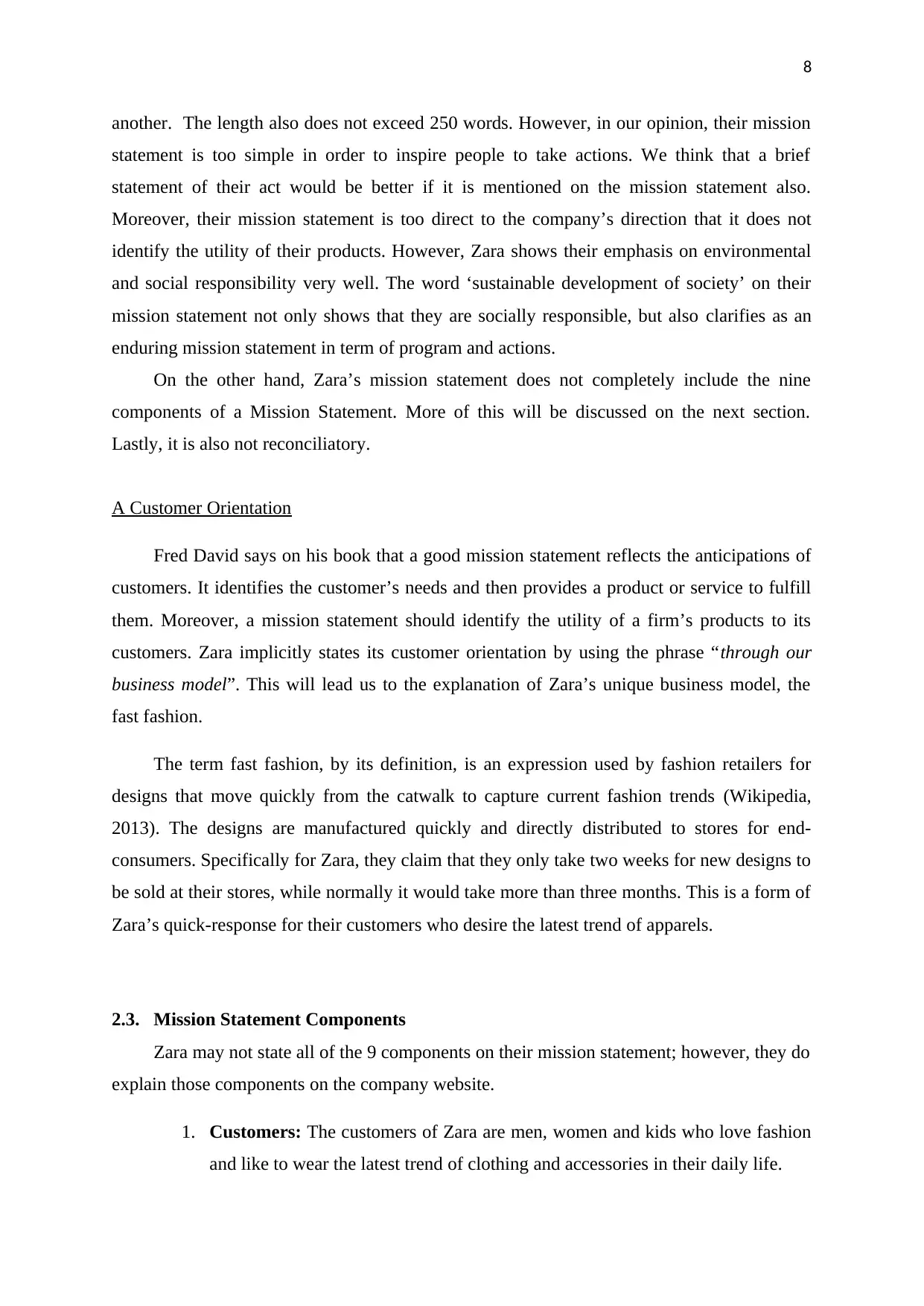
8
another. The length also does not exceed 250 words. However, in our opinion, their mission
statement is too simple in order to inspire people to take actions. We think that a brief
statement of their act would be better if it is mentioned on the mission statement also.
Moreover, their mission statement is too direct to the company’s direction that it does not
identify the utility of their products. However, Zara shows their emphasis on environmental
and social responsibility very well. The word ‘sustainable development of society’ on their
mission statement not only shows that they are socially responsible, but also clarifies as an
enduring mission statement in term of program and actions.
On the other hand, Zara’s mission statement does not completely include the nine
components of a Mission Statement. More of this will be discussed on the next section.
Lastly, it is also not reconciliatory.
A Customer Orientation
Fred David says on his book that a good mission statement reflects the anticipations of
customers. It identifies the customer’s needs and then provides a product or service to fulfill
them. Moreover, a mission statement should identify the utility of a firm’s products to its
customers. Zara implicitly states its customer orientation by using the phrase “through our
business model”. This will lead us to the explanation of Zara’s unique business model, the
fast fashion.
The term fast fashion, by its definition, is an expression used by fashion retailers for
designs that move quickly from the catwalk to capture current fashion trends (Wikipedia,
2013). The designs are manufactured quickly and directly distributed to stores for end-
consumers. Specifically for Zara, they claim that they only take two weeks for new designs to
be sold at their stores, while normally it would take more than three months. This is a form of
Zara’s quick-response for their customers who desire the latest trend of apparels.
2.3. Mission Statement Components
Zara may not state all of the 9 components on their mission statement; however, they do
explain those components on the company website.
1. Customers: The customers of Zara are men, women and kids who love fashion
and like to wear the latest trend of clothing and accessories in their daily life.
another. The length also does not exceed 250 words. However, in our opinion, their mission
statement is too simple in order to inspire people to take actions. We think that a brief
statement of their act would be better if it is mentioned on the mission statement also.
Moreover, their mission statement is too direct to the company’s direction that it does not
identify the utility of their products. However, Zara shows their emphasis on environmental
and social responsibility very well. The word ‘sustainable development of society’ on their
mission statement not only shows that they are socially responsible, but also clarifies as an
enduring mission statement in term of program and actions.
On the other hand, Zara’s mission statement does not completely include the nine
components of a Mission Statement. More of this will be discussed on the next section.
Lastly, it is also not reconciliatory.
A Customer Orientation
Fred David says on his book that a good mission statement reflects the anticipations of
customers. It identifies the customer’s needs and then provides a product or service to fulfill
them. Moreover, a mission statement should identify the utility of a firm’s products to its
customers. Zara implicitly states its customer orientation by using the phrase “through our
business model”. This will lead us to the explanation of Zara’s unique business model, the
fast fashion.
The term fast fashion, by its definition, is an expression used by fashion retailers for
designs that move quickly from the catwalk to capture current fashion trends (Wikipedia,
2013). The designs are manufactured quickly and directly distributed to stores for end-
consumers. Specifically for Zara, they claim that they only take two weeks for new designs to
be sold at their stores, while normally it would take more than three months. This is a form of
Zara’s quick-response for their customers who desire the latest trend of apparels.
2.3. Mission Statement Components
Zara may not state all of the 9 components on their mission statement; however, they do
explain those components on the company website.
1. Customers: The customers of Zara are men, women and kids who love fashion
and like to wear the latest trend of clothing and accessories in their daily life.
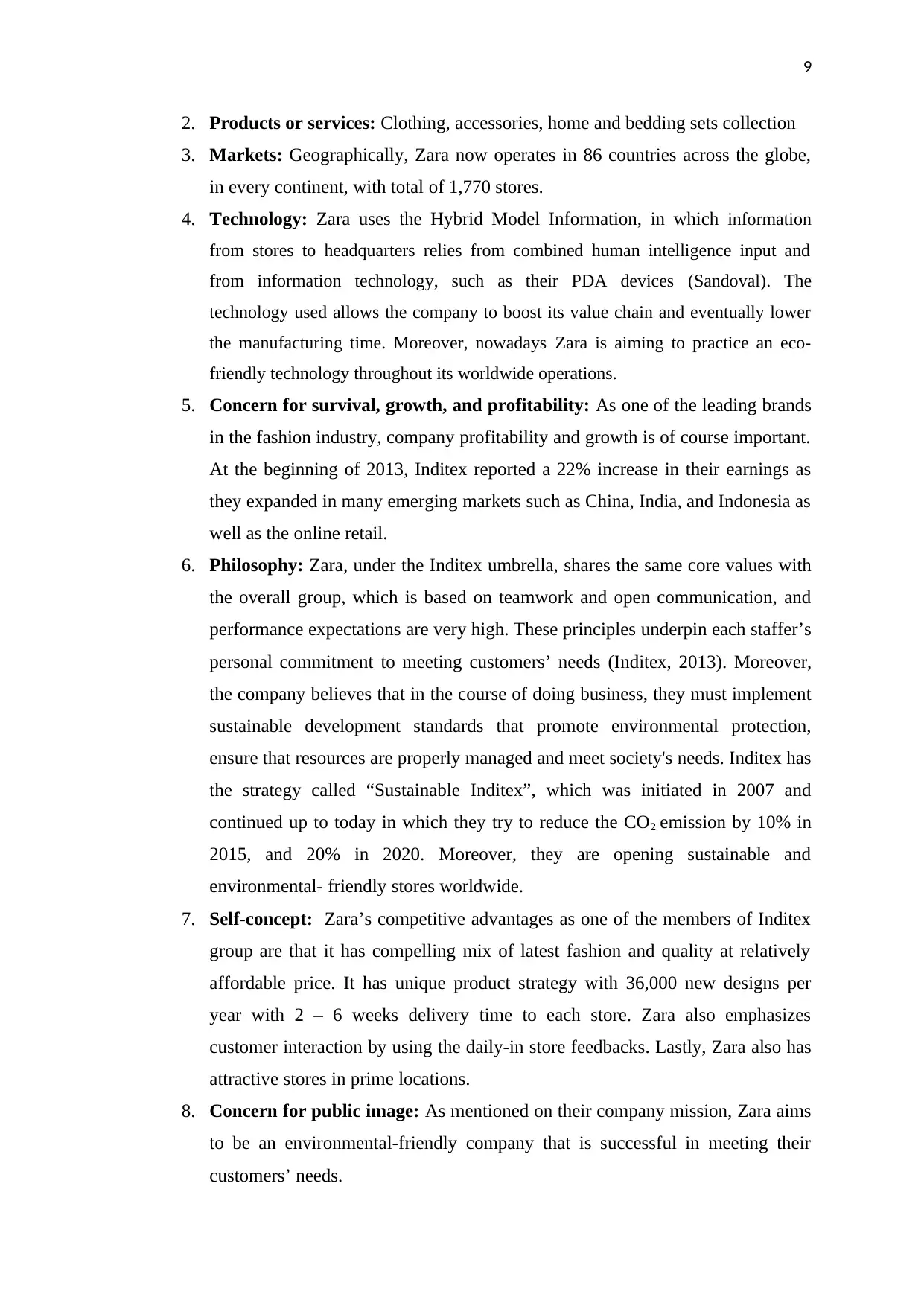
9
2. Products or services: Clothing, accessories, home and bedding sets collection
3. Markets: Geographically, Zara now operates in 86 countries across the globe,
in every continent, with total of 1,770 stores.
4. Technology: Zara uses the Hybrid Model Information, in which information
from stores to headquarters relies from combined human intelligence input and
from information technology, such as their PDA devices (Sandoval). The
technology used allows the company to boost its value chain and eventually lower
the manufacturing time. Moreover, nowadays Zara is aiming to practice an eco-
friendly technology throughout its worldwide operations.
5. Concern for survival, growth, and profitability: As one of the leading brands
in the fashion industry, company profitability and growth is of course important.
At the beginning of 2013, Inditex reported a 22% increase in their earnings as
they expanded in many emerging markets such as China, India, and Indonesia as
well as the online retail.
6. Philosophy: Zara, under the Inditex umbrella, shares the same core values with
the overall group, which is based on teamwork and open communication, and
performance expectations are very high. These principles underpin each staffer’s
personal commitment to meeting customers’ needs (Inditex, 2013). Moreover,
the company believes that in the course of doing business, they must implement
sustainable development standards that promote environmental protection,
ensure that resources are properly managed and meet society's needs. Inditex has
the strategy called “Sustainable Inditex”, which was initiated in 2007 and
continued up to today in which they try to reduce the CO2 emission by 10% in
2015, and 20% in 2020. Moreover, they are opening sustainable and
environmental- friendly stores worldwide.
7. Self-concept: Zara’s competitive advantages as one of the members of Inditex
group are that it has compelling mix of latest fashion and quality at relatively
affordable price. It has unique product strategy with 36,000 new designs per
year with 2 – 6 weeks delivery time to each store. Zara also emphasizes
customer interaction by using the daily-in store feedbacks. Lastly, Zara also has
attractive stores in prime locations.
8. Concern for public image: As mentioned on their company mission, Zara aims
to be an environmental-friendly company that is successful in meeting their
customers’ needs.
2. Products or services: Clothing, accessories, home and bedding sets collection
3. Markets: Geographically, Zara now operates in 86 countries across the globe,
in every continent, with total of 1,770 stores.
4. Technology: Zara uses the Hybrid Model Information, in which information
from stores to headquarters relies from combined human intelligence input and
from information technology, such as their PDA devices (Sandoval). The
technology used allows the company to boost its value chain and eventually lower
the manufacturing time. Moreover, nowadays Zara is aiming to practice an eco-
friendly technology throughout its worldwide operations.
5. Concern for survival, growth, and profitability: As one of the leading brands
in the fashion industry, company profitability and growth is of course important.
At the beginning of 2013, Inditex reported a 22% increase in their earnings as
they expanded in many emerging markets such as China, India, and Indonesia as
well as the online retail.
6. Philosophy: Zara, under the Inditex umbrella, shares the same core values with
the overall group, which is based on teamwork and open communication, and
performance expectations are very high. These principles underpin each staffer’s
personal commitment to meeting customers’ needs (Inditex, 2013). Moreover,
the company believes that in the course of doing business, they must implement
sustainable development standards that promote environmental protection,
ensure that resources are properly managed and meet society's needs. Inditex has
the strategy called “Sustainable Inditex”, which was initiated in 2007 and
continued up to today in which they try to reduce the CO2 emission by 10% in
2015, and 20% in 2020. Moreover, they are opening sustainable and
environmental- friendly stores worldwide.
7. Self-concept: Zara’s competitive advantages as one of the members of Inditex
group are that it has compelling mix of latest fashion and quality at relatively
affordable price. It has unique product strategy with 36,000 new designs per
year with 2 – 6 weeks delivery time to each store. Zara also emphasizes
customer interaction by using the daily-in store feedbacks. Lastly, Zara also has
attractive stores in prime locations.
8. Concern for public image: As mentioned on their company mission, Zara aims
to be an environmental-friendly company that is successful in meeting their
customers’ needs.
⊘ This is a preview!⊘
Do you want full access?
Subscribe today to unlock all pages.

Trusted by 1+ million students worldwide
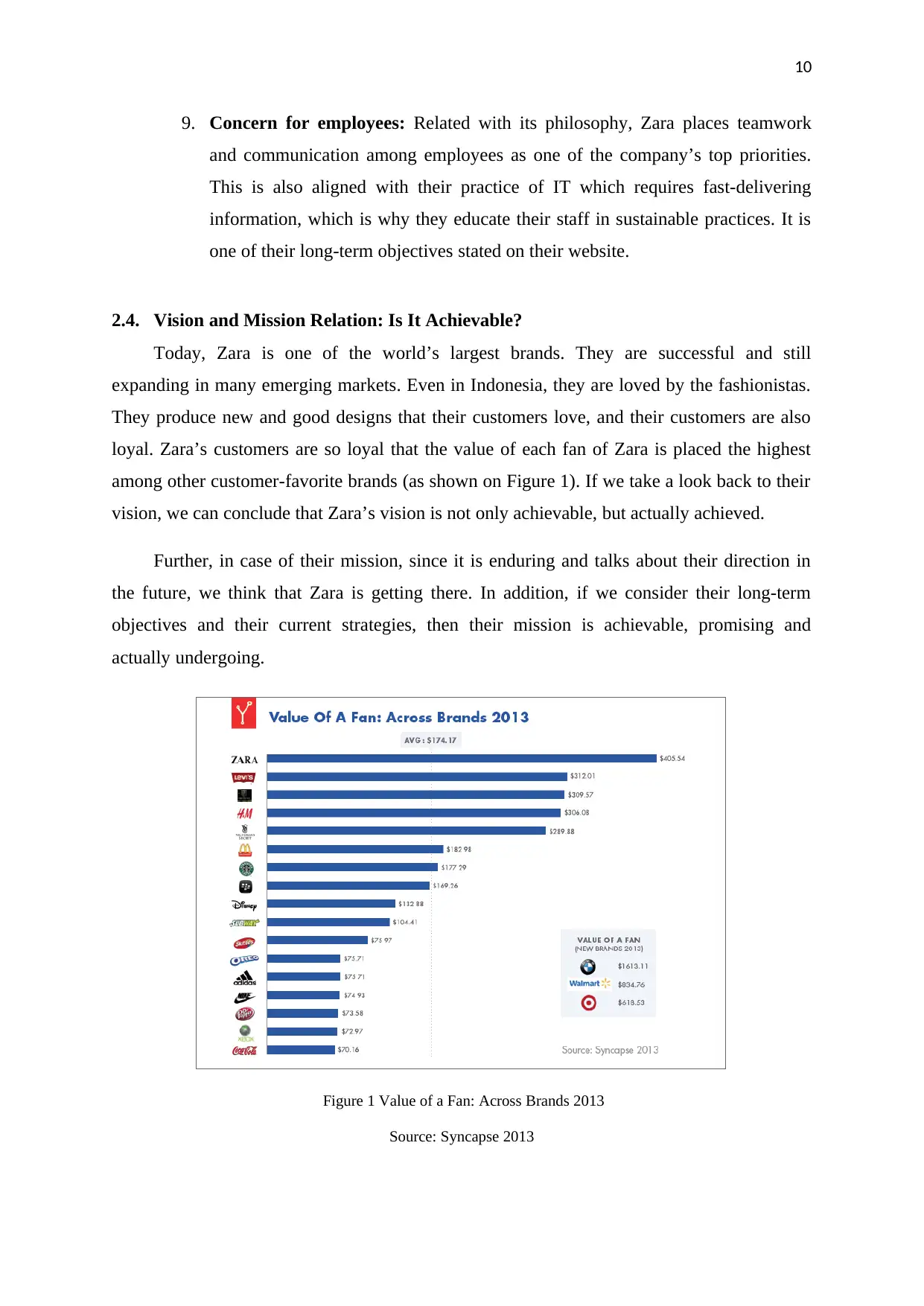
10
9. Concern for employees: Related with its philosophy, Zara places teamwork
and communication among employees as one of the company’s top priorities.
This is also aligned with their practice of IT which requires fast-delivering
information, which is why they educate their staff in sustainable practices. It is
one of their long-term objectives stated on their website.
2.4. Vision and Mission Relation: Is It Achievable?
Today, Zara is one of the world’s largest brands. They are successful and still
expanding in many emerging markets. Even in Indonesia, they are loved by the fashionistas.
They produce new and good designs that their customers love, and their customers are also
loyal. Zara’s customers are so loyal that the value of each fan of Zara is placed the highest
among other customer-favorite brands (as shown on Figure 1). If we take a look back to their
vision, we can conclude that Zara’s vision is not only achievable, but actually achieved.
Further, in case of their mission, since it is enduring and talks about their direction in
the future, we think that Zara is getting there. In addition, if we consider their long-term
objectives and their current strategies, then their mission is achievable, promising and
actually undergoing.
Figure 1 Value of a Fan: Across Brands 2013
Source: Syncapse 2013
9. Concern for employees: Related with its philosophy, Zara places teamwork
and communication among employees as one of the company’s top priorities.
This is also aligned with their practice of IT which requires fast-delivering
information, which is why they educate their staff in sustainable practices. It is
one of their long-term objectives stated on their website.
2.4. Vision and Mission Relation: Is It Achievable?
Today, Zara is one of the world’s largest brands. They are successful and still
expanding in many emerging markets. Even in Indonesia, they are loved by the fashionistas.
They produce new and good designs that their customers love, and their customers are also
loyal. Zara’s customers are so loyal that the value of each fan of Zara is placed the highest
among other customer-favorite brands (as shown on Figure 1). If we take a look back to their
vision, we can conclude that Zara’s vision is not only achievable, but actually achieved.
Further, in case of their mission, since it is enduring and talks about their direction in
the future, we think that Zara is getting there. In addition, if we consider their long-term
objectives and their current strategies, then their mission is achievable, promising and
actually undergoing.
Figure 1 Value of a Fan: Across Brands 2013
Source: Syncapse 2013
Paraphrase This Document
Need a fresh take? Get an instant paraphrase of this document with our AI Paraphraser
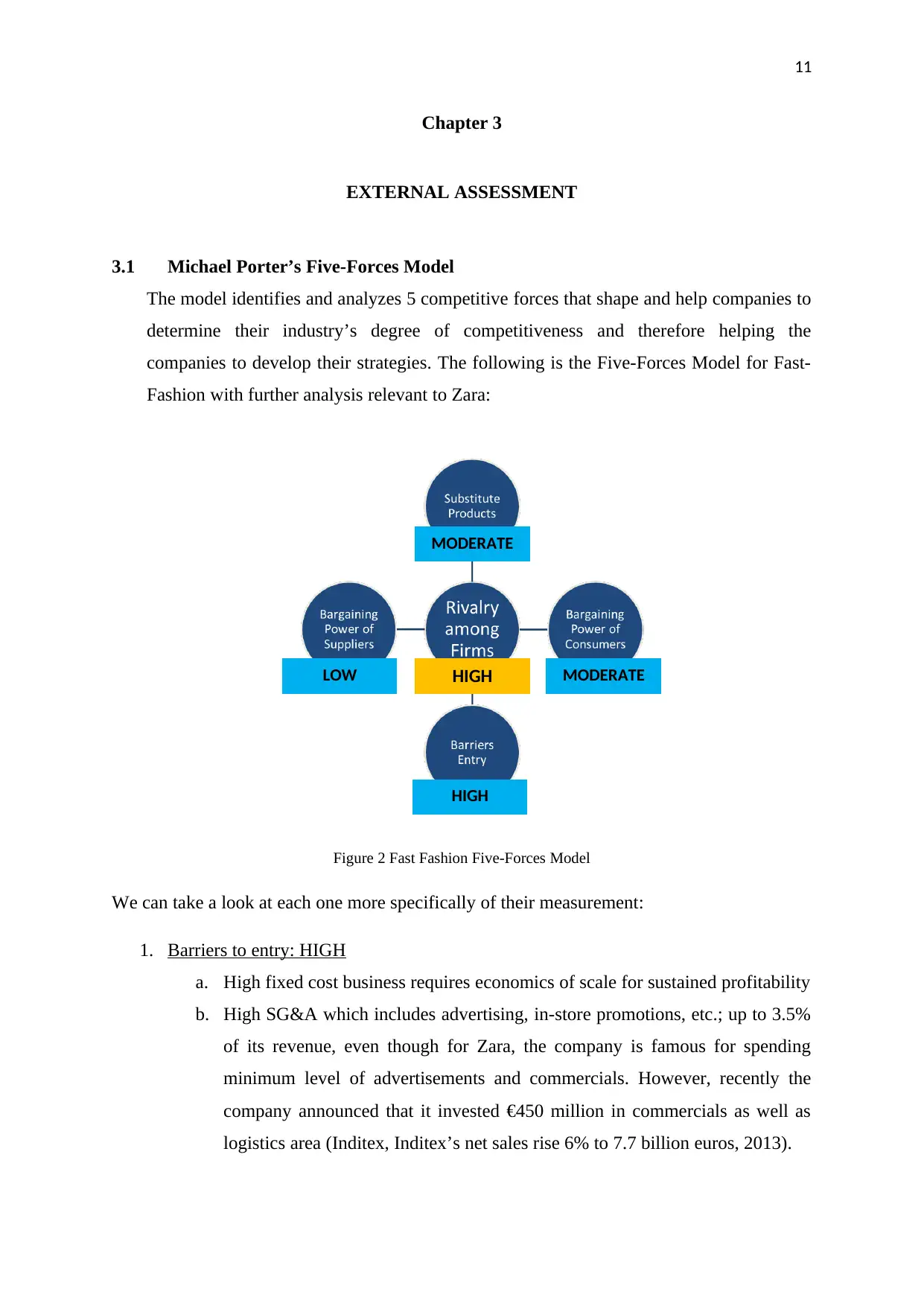
11
Chapter 3
EXTERNAL ASSESSMENT
3.1 Michael Porter’s Five-Forces Model
The model identifies and analyzes 5 competitive forces that shape and help companies to
determine their industry’s degree of competitiveness and therefore helping the
companies to develop their strategies. The following is the Five-Forces Model for Fast-
Fashion with further analysis relevant to Zara:
Figure 2 Fast Fashion Five-Forces Model
We can take a look at each one more specifically of their measurement:
1. Barriers to entry: HIGH
a. High fixed cost business requires economics of scale for sustained profitability
b. High SG&A which includes advertising, in-store promotions, etc.; up to 3.5%
of its revenue, even though for Zara, the company is famous for spending
minimum level of advertisements and commercials. However, recently the
company announced that it invested €450 million in commercials as well as
logistics area (Inditex, Inditex’s net sales rise 6% to 7.7 billion euros, 2013).
MODERATE
MODERATE
HIGH
HIGHLOW
Chapter 3
EXTERNAL ASSESSMENT
3.1 Michael Porter’s Five-Forces Model
The model identifies and analyzes 5 competitive forces that shape and help companies to
determine their industry’s degree of competitiveness and therefore helping the
companies to develop their strategies. The following is the Five-Forces Model for Fast-
Fashion with further analysis relevant to Zara:
Figure 2 Fast Fashion Five-Forces Model
We can take a look at each one more specifically of their measurement:
1. Barriers to entry: HIGH
a. High fixed cost business requires economics of scale for sustained profitability
b. High SG&A which includes advertising, in-store promotions, etc.; up to 3.5%
of its revenue, even though for Zara, the company is famous for spending
minimum level of advertisements and commercials. However, recently the
company announced that it invested €450 million in commercials as well as
logistics area (Inditex, Inditex’s net sales rise 6% to 7.7 billion euros, 2013).
MODERATE
MODERATE
HIGH
HIGHLOW
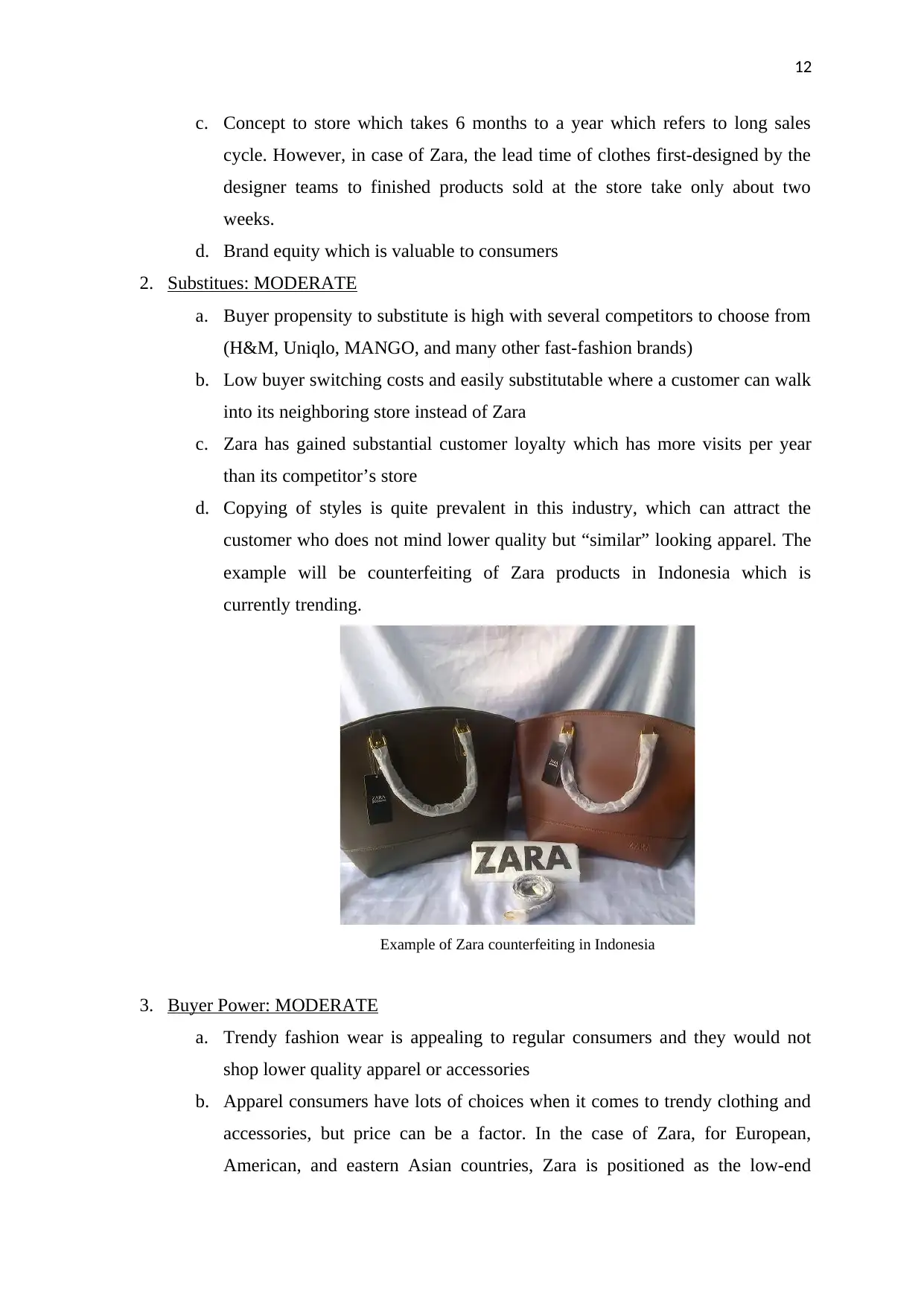
12
c. Concept to store which takes 6 months to a year which refers to long sales
cycle. However, in case of Zara, the lead time of clothes first-designed by the
designer teams to finished products sold at the store take only about two
weeks.
d. Brand equity which is valuable to consumers
2. Substitues: MODERATE
a. Buyer propensity to substitute is high with several competitors to choose from
(H&M, Uniqlo, MANGO, and many other fast-fashion brands)
b. Low buyer switching costs and easily substitutable where a customer can walk
into its neighboring store instead of Zara
c. Zara has gained substantial customer loyalty which has more visits per year
than its competitor’s store
d. Copying of styles is quite prevalent in this industry, which can attract the
customer who does not mind lower quality but “similar” looking apparel. The
example will be counterfeiting of Zara products in Indonesia which is
currently trending.
Example of Zara counterfeiting in Indonesia
3. Buyer Power: MODERATE
a. Trendy fashion wear is appealing to regular consumers and they would not
shop lower quality apparel or accessories
b. Apparel consumers have lots of choices when it comes to trendy clothing and
accessories, but price can be a factor. In the case of Zara, for European,
American, and eastern Asian countries, Zara is positioned as the low-end
c. Concept to store which takes 6 months to a year which refers to long sales
cycle. However, in case of Zara, the lead time of clothes first-designed by the
designer teams to finished products sold at the store take only about two
weeks.
d. Brand equity which is valuable to consumers
2. Substitues: MODERATE
a. Buyer propensity to substitute is high with several competitors to choose from
(H&M, Uniqlo, MANGO, and many other fast-fashion brands)
b. Low buyer switching costs and easily substitutable where a customer can walk
into its neighboring store instead of Zara
c. Zara has gained substantial customer loyalty which has more visits per year
than its competitor’s store
d. Copying of styles is quite prevalent in this industry, which can attract the
customer who does not mind lower quality but “similar” looking apparel. The
example will be counterfeiting of Zara products in Indonesia which is
currently trending.
Example of Zara counterfeiting in Indonesia
3. Buyer Power: MODERATE
a. Trendy fashion wear is appealing to regular consumers and they would not
shop lower quality apparel or accessories
b. Apparel consumers have lots of choices when it comes to trendy clothing and
accessories, but price can be a factor. In the case of Zara, for European,
American, and eastern Asian countries, Zara is positioned as the low-end
⊘ This is a preview!⊘
Do you want full access?
Subscribe today to unlock all pages.

Trusted by 1+ million students worldwide
1 out of 64
Related Documents
Your All-in-One AI-Powered Toolkit for Academic Success.
+13062052269
info@desklib.com
Available 24*7 on WhatsApp / Email
![[object Object]](/_next/static/media/star-bottom.7253800d.svg)
Unlock your academic potential
Copyright © 2020–2025 A2Z Services. All Rights Reserved. Developed and managed by ZUCOL.





